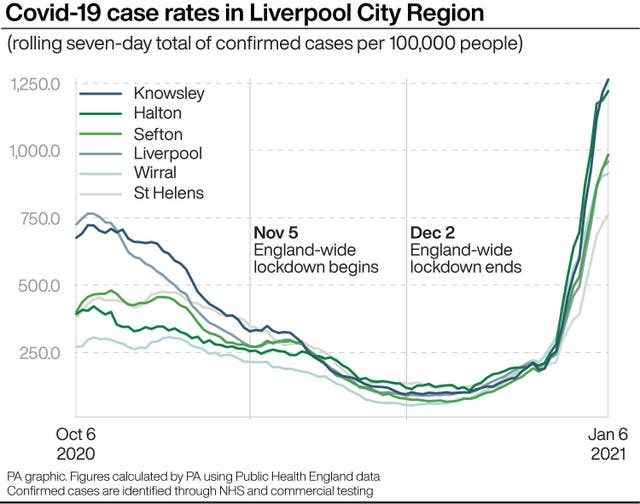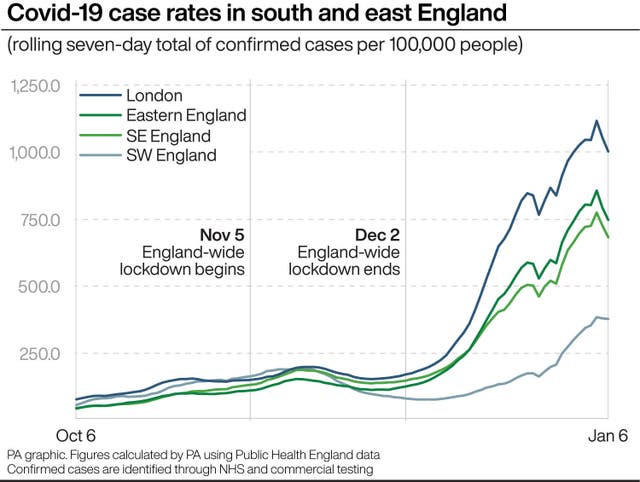The biggest increases in Covid-19 case rates are now happening outside the south and east of England, latest figures show.
The Liverpool City Region and parts of the West Midlands have seen particularly sharp rises.
In Knowsley on Merseyside the rate has soared from 455.4 cases per 100,000 in the seven days to December 30 to 1,263.4 per 100,000 in the seven days to January 6 – the biggest week-on-week rise for any local authority area in England.
Halton in Cheshire, which is also part of the Liverpool City Region, saw the second biggest jump, from 533.2 to 1,220.2.
And Liverpool itself recorded the third largest increase, from 387.5 to 958.6.

All six authorities in the Liverpool City Region are currently in the top 10 local areas with the biggest week-on-week jump in rates.
Wolverhampton, Sandwell and Walsall – all within the West Midlands metropolitan county – have also seen sharp increases.
In Wolverhampton rates have jumped from 638.3 to 1,033.6, in Sandwell they are up from 567.5 to 953.0, and in Walsall they have risen from 497.1 to 815.5.
The figures show how the rapid increase in rates seen in London and much of south-east and eastern England at the end of December has now spread to other parts of the country.
And while the highest rates in England continue to be recorded in the south and east, here the week-on-week increases are much smaller.
In some areas of Essex the rates have even fallen slightly, such as Thurrock (down from 1,413.3 to 1,340.5), Castle Point (down from 1,291.3 to 1,254.8) and Epping Forest (down from 1,340.3 to 1,214.2).
The sharp increase in rates across the Liverpool City Region has yet to be seen in nearby Greater Manchester, though other areas in north-west England are now recording large jumps, including Pendle and Burnley in Lancashire, and Carlisle and Copeland in Cumbria.
Elsewhere there have been large jumps in case rates for Corby in the East Midlands (up from 473.6 to 945.7), the Isle of Wight (up from 601.7 to 1,120.1), and Bournemouth, Christchurch & Poole (up from 450.0 to 804.9).

All regions of England continue to record a week-on-week increase in rates, though there are signs in the South and East that the rise is slowing.
In London the rate stood at 1,000.9 cases per 100,000 people in the seven days to January 6, up slightly from 965.4 in the previous week.
In eastern England the rate is up from 707.9 to 746.9, and in south-east England it has risen from 633.8 to 682.2.
Provisional data suggests the rates in these regions may have fallen in the last few days, though it is too soon to say if this is a permanent trend.
All figures have been calculated by the PA news agency based on the latest data published by Public Health England.










